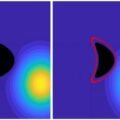A November, 2021 video animation from NASA shows how their soon to be launched demonstrator spacecraft will test laser communications in space, both between two satellites as well as between the International Space Station and Earth. Dubbed the “Laser Communications Relay Demonstrator,” or LCRD, the system is designed to prove the viability of using fiber-optic style laser communications in space, only without physical cables between sender and receiver.
BACKGROUND: BENEFITS OF LASERS FOR COMMUNICATION
On Earth, the fiber optic network covering much of the developed world allows for near instantaneous transmission and receipt of high definition images, audio and video. This capability is not available to the actual geosynchronous satellites that communicate much of these transmissions from thousands of miles above Earth’s surface. That’s mostly because of the disruptive nature of Earth’s atmosphere and magnetic field, not to mention the fact that stringing an actual fiber optic cable from Earth to these satellites is currently impossible.
“The Earth’s atmosphere distorts laser beams due to turbulence,” said Jason Mitchell, Director of the Advanced Communications and Navigation Technology division in the Space Communications and Navigation (SCaN) program at NASA Headquarters in a recent mission press release. “Understanding these challenges are critical to enabling operational optical communications relay capability.”
ANALYSIS: NASA VIDEO DEMONSTRATES THE TECHNOLOGY
Now, NASA has released a video animation of the upcoming LCRD mission that they believe can conquer this final frontier, bringing the superior capabilities and advantages of laser communications to satellites and Earth-based stations alike.
“Generally, commercial efforts have been focused on developing space-to-space laser systems for use in low-Earth orbit,” the press release explains. “Companies are investing in satellite constellations which leverage laser communications to provide global broadband coverage.”
Such proposed constellations, the same release notes, have anywhere from several hundreds to several thousands of satellites, designed to create an extensive in-space laser communications network.
“Commercial constellations still largely rely on radio frequency links to send data back to Earth,” the release adds. “Whereas, LCRD uses lasers for both in-space and direct-to-Earth communications.”
OUTLOOK: WATCHING LASERS MAKE THE ISS GO HIGH DEF
According to the same press release, “The U.S. Department of Defense’s Space Test Program Satellite-6 (STPSat-6), part of the Space Test Program 3 (STP-3) mission, will launch on a United Launch Alliance Atlas V 551 rocket from the Cape Canaveral Space Force Station in Florida no earlier than December 5, 2021.”
And, says NASA, LCRD will be part of that imminently launched payload.
“LCRD includes commercially designed and built components alongside custom, NASA-developed systems,” the press release explains. “The optical module, which sends lasers to and from the payload, was designed by the Massachusetts Institute of Technology Lincoln Laboratory and built at NASA’s Goddard Space Flight Center in Greenbelt, Maryland.”
Now, go watch the short-yet-undeniably-cool video.
Follow and connect with author Christopher Plain on Twitter: @plain_fiction
